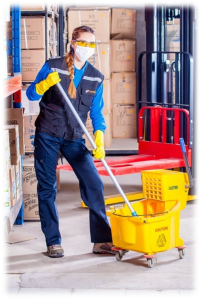3.3 Chemicals and Personal Protective Equipment
Chemicals
The following section provides an overview of common disinfectant chemicals that may be used by the housekeeping and custodial staff.
Isopropanol Alcohol
Chlorines
Phenolic
Quaternary Ammonium Compounds (QUATS)
Iodophors
Hydrogen Peroxides
Mix 50% hydrogen peroxide with 50% water. Spray the mixture on surfaces and allow a contact time of five minutes. Hydrogen peroxide is an economical, cost effective disinfectant which is also eco-friendly. Being knowledgeable about different chemical disinfectants allows managers to compare the positives and negatives of each one, enabling them to make the best choice for their team.
| Disinfectant | Expectations |
|---|---|
| Alcohols – 60-90% ethyl or isopropyl alcohol | Lengthy contact time |
| Chlorines – most common bleach | Harmful in terms of human exposure |
| Phenolics | Can also be used as a sterilization agent |
| Quaternary Ammonium Compounds (QUATS) | Safe choice in terms of human exposure/short contact time |
| Iodophors: Iodine, detergent, and water | Water temperature sensitive. Leaves an orange/brown residue |
| Accelerated hydrogen peroxides | Cost-effective, environmentally friendly |
What is Personal Protective Equipment (PPE)?
PPE is equipment worn or used by a worker to minimize exposure to specific hazards. Examples of PPE include respirators, gloves, aprons, fall protection, and full body suits, as well as head, eye, and foot protection. Using PPE is only one element in a complete hazard control program that would use a variety of strategies to maintain a safe and healthy environment. PPE does not reduce the hazard itself, nor does it guarantee permanent or total protection.
When Should Personal Protective Equipment (PPE) be Used?
PPE is used to reduce or minimize the exposure or contact to harmful physical, chemical, ergonomic, or biological agents. Remember, a hazard is not “gone” when PPE is used, but the risk of injury may be reduced. For example, wearing hearing protection reduces the likelihood of hearing damage when the earplugs or muffs are appropriate for the kind of noise exposure and when the PPE is used properly. However, using hearing protection does not eliminate the noise.
PPE should only be used:
- as an interim (short-term) measure before more effective controls are implemented;
- where other controls are not available or adequate;
- during activities such as maintenance, clean up, and repair, where more effective controls are not feasible or adequate;
- during emergency situations.
Designing an Effective PPE Program, https://www.ccohs.ca/oshanswers/prevention/ppe/designin.html, OSH Answers, Canadian Centre for Occupational Health and Safety (CCOHS), January 21, 2025. Reproduced with the permission of CCOHS, 2025.

In housekeeping and laundry departments, PPE often consists of gloves, aprons, eyewear, and masks.
 View a Personal Protective Equipment PDF from the Canadian Centre for Occupational Health and Safety.
View a Personal Protective Equipment PDF from the Canadian Centre for Occupational Health and Safety.For information on safe chemical handling and proper PPE use, consult the resources offered by the Canadian Centre for Occupational Health and Safety.

